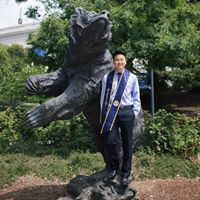Ho S Lee
age ~76
from San Diego, CA
- Also known as:
-
- Ho O Lee
- Hosong Lee
- Ho Slee
- Song Chris Ho
- Song Lee Ho
Ho Lee Phones & Addresses
- San Diego, CA
- Cerritos, CA
- Chula Vista, CA
Lawyers & Attorneys

Ho Min Lee - Lawyer
view sourceAddress:
Defense Acquisition Program Administration
(220)796249x (Office)
(220)796249x (Office)
Licenses:
New York - Currently registered 2010
Education:
New York University School of Law

Ho Lee - Lawyer
view sourceSpecialties:
Business Law
ISLN:
923889232
Admitted:
2010
University:
New York University School of Law
License Records
Ho Bu Lee
License #:
0225091323
Category:
Real Estate Individual
Name / Title
Company / Classification
Phones & Addresses
President
Dare Designs
Business Services
Business Services
618 S Serrano Ave, Los Angeles, CA 90005
President
Urban T, Inc
1501 Santee St, Los Angeles, CA 90015
President
Fine Tree, Inc
600 E Washington Blvd, Los Angeles, CA 90015
Owner
My Fashion
Whol Women's/Child's Clothing Mfg Women's/Misses' Outerwear
Whol Women's/Child's Clothing Mfg Women's/Misses' Outerwear
228 E 11 St, Los Angeles, CA 90015
(213)7463834
(213)7463834
President
Mj Minerals, Inc
3255 Wilshire Blvd, Los Angeles, CA 90010
President
Ho Sik Lee Logistics
349 S Ln Fayette Park Pl, Los Angeles, CA 90057
President
Coco Grooming, Inc
28427 Hazelridge Dr, Palos Verdes Estates, CA 90275
President
Three Joys Foundation
1201 S Bch Blvd, La Habra, CA 90631
Isbn (Books And Publications)


Resumes

Owner, Xenos Fashion.inc
view sourcePosition:
Owner at xenos fashion.inc
Location:
Orange County, California Area
Industry:
Wholesale
Work:
xenos fashion.inc
Owner
Owner

Owner, Ifa
view sourcePosition:
Owner at IFA
Location:
Greater Los Angeles Area
Industry:
Financial Services
Work:
IFA
Owner
Owner

Project Integrator At Crystal Managemetn Consulting
view sourcePosition:
Project Integrator at Crystal Managemetn Consulting
Location:
US Military Posts in the Pacific
Industry:
Computer Software
Work:
Crystal Managemetn Consulting
Project Integrator
Project Integrator

Ho Lee
view sourceLocation:
United States

General Counsel At Cmg Brands Llc
view sourceLocation:
Greater Los Angeles Area
Industry:
Entertainment

Sr. Strategic Research Consultant At Toyota
view sourceLocation:
Greater Los Angeles Area
Industry:
Market Research
Medicine Doctors

Dr. Ho Je Lee - MD (Doctor of Medicine)
view sourceHospitals:
607 N Central Ave Suite 208, Glendale, CA 91203
Glendale Memorial Hospital and Health Center
1420 South Central Avenue, Glendale, CA 91204
Glendale Memorial Hospital and Health Center
1420 South Central Avenue, Glendale, CA 91204
Philosophy:
To provide the most complete care to my patients in a caring and respectful way.
Education:
Medical Schools
American University Of The Caribbean School Of Medicine
Graduated: 2006
American University Of The Caribbean School Of Medicine
Graduated: 2006

Ho H. Lee
view sourceSpecialties:
Orthopaedic Surgery
Work:
Kaiser Permanente Medical GroupKaiser Permanente Fontana Medical Center
9961 Sierra Ave, Fontana, CA 92335
(909)4275000 (phone), (909)4277366 (fax)
9961 Sierra Ave, Fontana, CA 92335
(909)4275000 (phone), (909)4277366 (fax)
Education:
Medical School
University of California, Los Angeles David Geffen School of Medicine
Graduated: 2003
University of California, Los Angeles David Geffen School of Medicine
Graduated: 2003
Procedures:
Arthrocentesis
Knee Replacement
Hip Replacement
Knee Arthroscopy
Shoulder Arthroscopy
Knee Replacement
Hip Replacement
Knee Arthroscopy
Shoulder Arthroscopy
Conditions:
Osteoarthritis
Internal Derangement of Knee Cartilage
Internal Derangement of Knee Cartilage
Languages:
English
Description:
Dr. Lee graduated from the University of California, Los Angeles David Geffen School of Medicine in 2003. He works in Fontana, CA and specializes in Orthopaedic Surgery. Dr. Lee is affiliated with Kaiser Permanente Fontana Medical Center.

Ho Chang Lee
view sourceSpecialties:
Internal Medicine - Geriatrics
Work:
Yale Medical GroupThe Dorothy Adler Geriatrics Assessment Center
874 Howard Ave, New Haven, CT 06519
(203)6886361 (phone), (203)6883876 (fax)
874 Howard Ave, New Haven, CT 06519
(203)6886361 (phone), (203)6883876 (fax)
Education:
Medical School
Thomas Jefferson University, Jefferson Medical College
Graduated: 1997
Thomas Jefferson University, Jefferson Medical College
Graduated: 1997
Procedures:
Psychiatric Therapeutic Procedures
Conditions:
Dementia
Anxiety Phobic Disorders
Bipolar Disorder
Depressive Disorders
Schizophrenia
Anxiety Phobic Disorders
Bipolar Disorder
Depressive Disorders
Schizophrenia
Languages:
English
Spanish
Spanish
Description:
Dr. Lee graduated from the Thomas Jefferson University, Jefferson Medical College in 1997. He works in New Haven, CT and specializes in Internal Medicine - Geriatrics. Dr. Lee is affiliated with Yale New Haven Hospital.

Ho W. Lee
view sourceSpecialties:
Nephrology
Work:
Pacific Nephrology AssocsPacific Nephrology Associates
1901 S Un Ave STE B7011, Tacoma, WA 98405
(253)6275755 (phone), (253)6277385 (fax)
1901 S Un Ave STE B7011, Tacoma, WA 98405
(253)6275755 (phone), (253)6277385 (fax)
Education:
Medical School
Yonsei Univ, Coll of Med, Sudai Moon Ku, Seoul, So Korea
Graduated: 2002
Yonsei Univ, Coll of Med, Sudai Moon Ku, Seoul, So Korea
Graduated: 2002
Conditions:
Chronic Renal Disease
Acute Renal Failure
Nephrotic Syndrome
Acute Renal Failure
Nephrotic Syndrome
Languages:
Chinese
English
Korean
English
Korean
Description:
Dr. Lee graduated from the Yonsei Univ, Coll of Med, Sudai Moon Ku, Seoul, So Korea in 2002. He works in Tacoma, WA and specializes in Nephrology. Dr. Lee is affiliated with MultiCare Allenmore Hospital, St Francis Hospital, St Joseph Medical Center and Tacoma General Hospital.

Ho K. Lee
view sourceSpecialties:
Radiology
Work:
Detroit Receiving Hospital
4201 Saint Antoine St, Detroit, MI 48201
(313)7453000 (phone), (313)7452788 (fax)
4201 Saint Antoine St, Detroit, MI 48201
(313)7453000 (phone), (313)7452788 (fax)
Education:
Medical School
Seoul Natl Univ, Coll of Med, Chongno Ku, Seoul, So Korea
Graduated: 1983
Seoul Natl Univ, Coll of Med, Chongno Ku, Seoul, So Korea
Graduated: 1983
Languages:
Chinese
English
Russian
Spanish
Tagalog
English
Russian
Spanish
Tagalog
Description:
Dr. Lee graduated from the Seoul Natl Univ, Coll of Med, Chongno Ku, Seoul, So Korea in 1983. He works in Detroit, MI and specializes in Radiology. Dr. Lee is affiliated with Detroit Receiving Hospital.

Ho Yan Lee
view sourceSpecialties:
Internal Medicine
Psychiatry
Diagnostic Radiology
Psychiatry
Diagnostic Radiology
Education:
Thomas Jefferson University (1997)

Ho Je Je Lee, Glendale CA
view sourceSpecialties:
Family Physician
Address:
1560 E Chevy Chase Dr, Glendale, CA 91206
946 N Brand Blvd, Glendale, CA 91202
946 N Brand Blvd, Glendale, CA 91202
Us Patents
-
Voice Compression System Having Robust In-Band Tone Signaling And Related Method
view source -
US Patent:59131896, Jun 15, 1999
-
Filed:Feb 12, 1997
-
Appl. No.:8/798690
-
Inventors:Ho Lee - San Diego CA
Jeanne Hall - San Diego CA
Dan Housam - Jefferson MD -
Assignee:Hughes Electronics Corporation - El Segundo CA
-
International Classification:G10L 300
H04L 1500 -
US Classification:704226
-
Abstract:A communication system, and related method, for reliably transmitting DTMF code signals through a low-bit rate channel employing a VSELP speech compression algorithm. The system adds relatively low-level noise to the analog DTMF signals before encoding by the compression algorithm. By adding the low-level noise to the DTMF signals, the tones associated with the DTMF signals can be reliably detected on the receiving end.
-
Robust Double-Talk Detection
view source -
US Patent:56029136, Feb 11, 1997
-
Filed:Sep 22, 1994
-
Appl. No.:8/310614
-
Inventors:Ho Lee - San Diego CA
Budi Hardiman - San Diego CA -
Assignee:Hughes Electronics - Los Angeles CA
-
International Classification:H04M 158
-
US Classification:379406
-
Abstract:A device and method for detecting and suppressing double-talk in a cellular mobile unit employ a cellular transceiver; a receive signal path; a transmit signal path; and a double-talk detector. The double-talk detector determines a receive slope of a receive signal, and determines a transmit slope of a transmit signal. The double-talk detector further determines a difference slope of a difference signal that is determined by evaluating differences between the receive signal and the transmit signal. Finally, the double-talk detector generates a double-talk flag signal in the event the transmit slope indicates an increasing transmit speech power, and the receive slope and the difference slope indicate a prescribed relationship between the changes in the receive speech power and the difference power.
-
Removal Of Swirl Artifacts From Celp-Based Speech Coders
view source -
US Patent:56339828, May 27, 1997
-
Filed:Oct 21, 1996
-
Appl. No.:8/734210
-
Inventors:Kalyan Ganesan - Germantown MD
Ho Lee - San Diego CA
Prabhat Gupta - Germantown MD -
Assignee:Hughes Electronics - Los Angeles CA
-
International Classification:G10L 900
G10L 506 -
US Classification:395 242
-
Abstract:The perception of speech processed by a CELP based coder, such as a VSELP coder, when operating in noisy background conditions is improved by removing swirl artifacts during silence periods. This is done by removing the low frequency components of the input signal when no speech is detected. A speech activity detector distinguishes between a periodic signal, like speech, and a non-periodic signal, like noise by using most of the VSELP coder internal parameters to determine the speech or non-speech conditions. To prevent the VSELP coder from determining pitches for non-periodic signals, a high pass filter is applied to the input signal to remove the pitch information for which the VSELP coder searches.
-
Infrared-Assisted Pre-Flash
view source -
US Patent:20210105392, Apr 8, 2021
-
Filed:Oct 2, 2019
-
Appl. No.:16/591543
-
Inventors:- San Diego CA, US
Ho Sang Lee - San Diego CA, US
Ying Noyes - San Diego CA, US -
International Classification:H04N 5/235
H04N 5/33
G03B 15/05
G03B 7/17
G03B 7/097 -
Abstract:Methods, systems, and devices for operating a camera-enabled device are described. The camera-enabled device may emit, via a first light emitting source, an infrared light in a physical environment and determine time-of-flight information associated with a target object in the physical environment based on the emitted infrared light. The camera-enabled device may estimate one or more exposure settings based on the time-of-flight information, and emit, via a second light emitting source, a visible light in the physical environment based on the estimated one or more exposure settings. As a result, the camera-enabled device may capture an image of the physical environment based on the emitted visible light and the estimated one or more exposure settings.
-
Multiple Frame Auto White Balance
view source -
US Patent:20210105448, Apr 8, 2021
-
Filed:Oct 3, 2019
-
Appl. No.:16/592648
-
Inventors:- San Diego CA, US
Ho Sang Lee - San Diego CA, US
Pradeep Veeramalla - Hyderabad, IN
Anshul Maheshwari - Hyderabad, IN
Shivakumar Manda - Hyderabad, IN -
International Classification:H04N 9/73
H04N 5/232
G06T 5/50 -
Abstract:Methods, systems, and devices for image processing at a device are described. The present disclosure may relate to capturing a first frame of image samples and a second frame of image samples of an image sensor after capturing the first frame of image samples, determining that a white balance confidence level of the second frame does not satisfy a confidence threshold, retrieving the first frame of image samples based on determining that the white balance confidence level of the second frame does not satisfy the confidence threshold, combining at least a portion of the image samples of the first frame with the image samples of the second frame, and determining a white balance setting for the second frame based on combining at least the portion of the image samples of the first frame with the image samples of the second frame.
-
Audio Based Image Capture Settings
view source -
US Patent:20200278833, Sep 3, 2020
-
Filed:Feb 27, 2020
-
Appl. No.:16/802984
-
Inventors:- San Diego CA, US
Ho Sang Lee - San Diego CA, US -
International Classification:G06F 3/16
G10L 15/183
H04N 9/31 -
Abstract:Methods, devices, and systems for determining image capture settings based on an audio input are disclosed. In some aspects, a device includes a memory, a camera including a lens and a sensor, and a processor coupled to the camera and the memory. The processor may be configured to receive an audio input, determine contextual information based on the audio input, determine one or more image capture settings based on the contextual information, and output the one or more image capture settings.
-
Tuning For Deep-Learning-Based Color Enhancement Systems
view source -
US Patent:20190311464, Oct 10, 2019
-
Filed:Apr 5, 2018
-
Appl. No.:15/946622
-
Inventors:- San Diego CA, US
Wei-Chih Liu - Taipei City, TW
Kyuseo Han - San Diego CA, US
Ying Noyes - San Diego CA, US
Ho Sang Lee - San Diego CA, US -
International Classification:G06T 5/00
G06T 7/90 -
Abstract:A device may obtain a pixel array representing an image and identify one or more representative metrics for the pixel array. The device may retrieve a first version of a mesh defining a color space, wherein the mesh includes a plurality of vertices and each vertex is associated with a respective set of color balance parameters. The device may identify a point in the color space corresponding to the pixel array based on the one or more representative metrics for the pixel array. The device may receive a tuning input comprising a set of color balance parameters for the point and generate a second version of the mesh by adding the point and the set of color balance parameters to the first version of the mesh. The device may output at least one color-corrected image based at least in part on the second version of the mesh.
-
Systems And Methods For Automatic White Balance
view source -
US Patent:20190253682, Aug 15, 2019
-
Filed:Sep 18, 2018
-
Appl. No.:16/134087
-
Inventors:- San Diego CA, US
Ho Sang Lee - San Diego CA, US
Kyuseo Han - San Diego CA, US
Pradeep Veeramalla - Hyderabad, IN -
International Classification:H04N 9/73
H04N 5/235 -
Abstract:Aspects of the present disclosure relate to systems and methods for performing automatic white balance (AWB). An example device may include a memory and a processor coupled to the memory. The processor may be configured to receive a first image of a scene, measure a first illuminant of the first received image, compare the first illuminant and a first illuminant value, determine the scene is changing between the first received image and a previous image based on the comparison, adjust a first AWB convergence rate to a second AWB convergence rate in response to determining the scene is changing, and converge from a first balancing factor to a second balancing factor for one or more white balance operations based on the second AWB convergence rate.
Youtube
Googleplus

Ho Lee
Education:
Shenzhen University - Computer Science
About:
李昊
Bragging Rights:
With great power, comes great responsibility.

Ho Lee
Relationship:
Single
About:
妳好

Ho Lee

Ho Lee

Ho Lee

Ho Lee

Ho Lee

Ho Lee
Flickr
Myspace
Plaxo

Ho John Lee
view sourceAdvisory Director at Peak Capital

Sang Ho Lee
view source
Jin Ho Lee
view source
Ho Lee
view sourcesiss technology

Jun Ho Lee
view source
Ho Lee Schitt
view source
Joo Ho Lee
view source
Ho Hyeong Lee
view source
Chul Ho Lee
view source
Soo Ho Lee
view source
Ho Jupiter Lee
view source
Pil Ho Lee
view sourceClassmates

Ho Lee
view sourceSchools:
First Academy Orlando FL 1997-2001
Community:
Mike Hall, Kristen Brewer, Jason Sanchez

Ho Ming Lee
view sourceSchools:
Charlestown High School Boston MA 1993-1997
Community:
Maureen Ahern

Ho Lee
view sourceSchools:
Greater Atlanta Christian School Norcross GA 1994-1998
Community:
Gay Allen, Laura Martin, Debbie Carter

Ho Ming Lee
view sourceSchools:
Ymca College Kowloon IL 1985-1989
Community:
Iu Sam, Yip Tam, Enoch Kwan, Wan Law, Wang Yam, Ka Tong

Ho Lee
view sourceSchools:
John Bowne Public School 20 Flushing NY 1983-1987
Community:
Mary Leist, Linda Comac, Heidi Proehl, Donald Ryerson, Bruce Pinkham, Deborah Hanson

Ho Kee Lee
view sourceSchools:
Wah Yan College Kowloon Hong Kong IL 1999-2003

Ho Lee (Dik)
view sourceSchools:
Senator O'Connor High School Toronto Morocco 1973-1977
Community:
Debbie Dunlop, William Garry

Min Ho Lee | Woodside Pri...
view sourceGet Report for Ho S Lee from San Diego, CA, age ~76






















